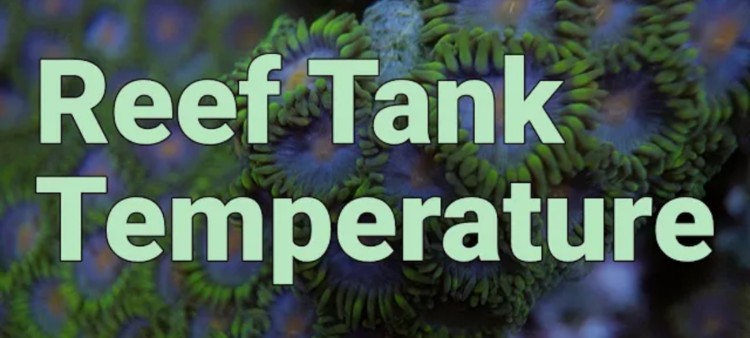What is the Ideal Temperature of a Reef Tank?
- Feb 03, 2022
- Anshika Mishra
- 936 0 0

The water temperature in your reef tank is one thing you can easily control. We have heaters when our aquariums are to cols, and we have got fans and chillers for when our the tank's too hot.
You can also use ice bags in a ziplock bag in an emergency. But what's the ideal temperature for a reef tank packed with colorful fish and coral from tropical reefs? And why should we even care to stay near it?
In this article, we will focus on tropical reefs, but there are variations too. For example, deeper water fish and corals prefer cooler temperatures, and very shallow tide pool creatures can withstand much higher temperatures for a short period.
There are even double insulted tanks made for very cold water, but that's beyond what we'll discuss here. It is very important to know what you are putting into your tank to don't mix animals with different care requirements that you cannot meet.
Finding the Ideal Temperature
So, how low is too low for our usual corals like Acropora, Montipora, Zoanthids, or other large polyp stony corals. What would be a good minimum reef tank temperature?
It turns out it is lower than you might think. Branching Acropora can survive down to about 14-degrees Celcius, which is about 57 Fahrenheit, for three days before their Zooxanthellae, which contributes so much energy, begins to leave their tissue, aka, they bleach and die.
Surviving is far from thriving, though, and metabolic activities slow and stop around 64 degrees Fahrenheit, so while the coral might survive, you should not expect it to survive long term or to grow at such low temperatures.
Some corals can protect themselves against low temperature by producing a slime coat that envelops the coral in a protective layer. Usually, massive mounding corals do this rather than branching corals. You can sometimes see this slime coat in shipping bags where the corals may have been exposed to less than the ideal temperatures during their transport.
There should be no big surprise here. If you search online for coral reef temperatures, you will find that water temperatures around 73 to 80 degrees Fahrenheit are ideal. Most people target about 25 Celcius or about 78 degrees Fahrenheit or so. It is easy to set a heater so that the water temperature won't drop below this level, but it is much harder to keep it increasing above that ideal level.
The average room-air temperature might work great, but lights and equipment contribute heat to our tank - and of course, at night, our lights are not on. So, we need heaters to keep the temperature within a stable range.
The temperature will increase during the day, and that's ok up to a point. For instance, in the south Pacific ocean, some reefs grow in temperature every day by about 3-degrees Fahrenheit, and some approach a 6-degrees swing every day.
So, it is fine if your tank swings a degree or two each day. However, be cautious of 6-degree swings in your tank.
Colling your tank
The big thing to remember is that you want to avoid holding the temperature at those elevated levels for a long time. A warm afternoon raising the temperature a degree or two is ok. However, a warm, sustained summer might kill your corals. In the same way, the increase in ocean temperature is killing our wild reefs.
The Use of Fans
To combat high reef tank temperature, you can use something as simple as a clip-on desk fan that you set on a time to run in the afternoon when your tank is the warmest. A more advanced version might be to use your tank's controller to turn on the fans when a certain temperature is reached.
The downside to fans, of course, is that they cool your tank by evaporating water. This adds a lot of humidity to your home, which can cause issues.
Chiller
Another option for cooling your tank is to buy a chiller. Aquarium chillers usually work in the same way that your refrigerators do, and they need similar maintenance overtime to replenish their coolant after years of use.
On a very small reef tank, your chiller may not even use coolant instead of cooling water using a Peltier plate device in a process called thermoelectric cooling. These types of chillers work best of small aquariums, may be less than 25 gallons or so in the nano reef range, and can only drop your tank's water a few degrees.
For keeping even the coldest water species, larger chillers with refrigerants can keep a tank downright cold. Larger chillers rely on vapor compressions and are also much more energy-efficient, but since they have fans and compressors, they are not silent.
That's said, most thermoelectric chillers use fans and a heatsink to cool the hot side and so they are usually not silent either.
Why Should you Care?
But why should we care about this? What is going on when corals are under heat-induced stress?
When Acrapora is subjected to a high water temperature for a long period, it starts to change its biological processes to survive. Instead of growing, it produces things like heat shock proteins that help repair the damage caused by the heat.
All this can also work up to a point, though, and all the energy and resources spent on combatting heat stress are resources are taken away from immunity growth and coloration. In the extreme cases, the corals might even bleach- and then, if you haven't been feeding your corals adequately, it is almost always fatal.
Of course, that is not ideal in our reef tank, but this is partially the process that helps many corals survive coral bleaching. We encourage setting the average reef tank's heater to about 77-degrees Fahrenheit.
Maintaining the Right Temperature
Pick your favorite way of keeping the temperature under control, and don't let it go over 80 Fahrenheit. If you choose fans, consider adding an automatic top-off system to your tank as well so that you don't cause big swings in salinity as you evaporate and replenish it all at once.
Don't underestimate the amount of water a fan blowing over the surface can evaporate!
If you have a nano reef, consider something like the Ice Probe cooler, which can reduce an average 10-gallon tank's water by a couple of degrees. You need to drill a hole in the tank adn tighten the device that doesn't have the glass. A controller will turn it off and on as needed without evaporating all your tank's water in the process.






About author